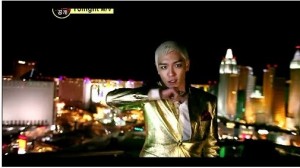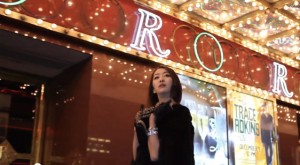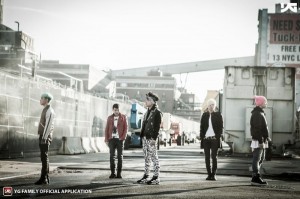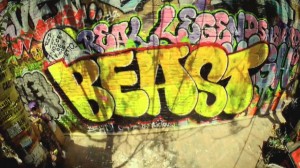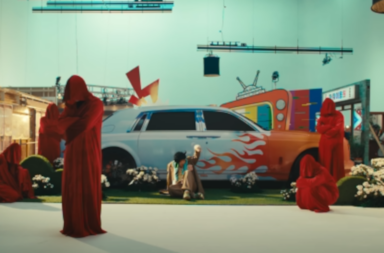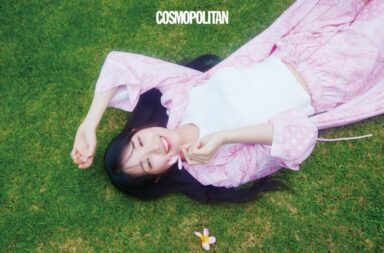The bright lights of the Las Vegas strip. The glamorous skyline of downtown Los Angeles. The colorful backstreets of inner-city New York. Which US backdrop would you prefer to see in a music video? The recent trend of shooting music videos in an exotic locale has had K-pop artists embarking upon Las Vegas, Los Angeles, and New York City as focal points for their US escapade. For those who are established enough (meaning they can afford the expense of shipping their artists overseas), the formula has been quite successful, generating attention-grabbing MVs for songs that would go on to become hits.
But does shooting in an iconic US city serve any larger purpose than simply boosting artists’ reputation or flaunting their production value? In other words, have artists made good use of showcasing these US cities in their MVs? For the most part, the artists who have utilized these US backdrops have quite wonderfully crafted the cinematography to allow the city to suit the song and influence the atmosphere, vibe, and tone of their MV. Although interpretations of a particular backdrop may differ tremendously by the type of song and artist, the iconic remnants of these different cities are brought to life even across different concepts and musical styles.
Let’s start with Las Vegas, Sin City, the home of Big Bang’s “Tonight” and Sistar’s “Alone.” Known for its excess in greed, glitz, and glamour, both Big Bang’s and Sistar’s MVs allow the city’s reputation to speak for itself. “Tonight” and “Alone” are both songs about loneliness and that theme is notably expressed by an idol walking down Las Vegas Boulevard, standing on a hotel balcony, or sitting inside a club, all by him/herself. It seems that members of both groups are having trouble getting over a recent breakup, and well, what better place is there to help get over someone than the city of sin? In this case, Las Vegas is the ideal backdrop for such a theme of loneliness because the bright lights and the outward affluence of the city contrast very strongly with the melancholy mood of our idols. They’re like that one friend you bring on a road trip to Las Vegas who can’t enjoy himself because he can’t stop crying about how his ex-girlfriend crushed his heart into a million pieces.
 The only thing better about being in Las Vegas is being single while in Las Vegas. This is where Big Bang’s song and MV goes into much more depth and intricacy than Sistar’s. While the MV for “Alone” is ultimately a dance video designed to show off Sistar’s finer assets, the MV for “Tonight” actually has somewhat of a storyline to go along with the shots of Big Bang posing in the Las Vegas nightlife and its surrounding dessert roads, while also sprinkling in brief glimpses of the beach and palm trees of Los Angeles (to be visited later). The song itself consists of verses sung by individual members of Big Bang who each express a different predicament that their character is going through. G-Dragon raps about being bored in his previous relationship and how he can’t be satisfied with just one partner. T.O.P raps about losing the spark and foreshadowing the end of his relationship. The other members sing about clinging to a brighter past, letting go of an unpleasant present, and of course, being all alone. For whatever reason that relationships get sour and entice former lovers to move on, the interlude between breaking up and finding new love, otherwise known as being single, is definitely a great time to visit Sin City! And one doesn’t always have to sulk like Sistar when they’re there. Daesung and T.O.P both end up bringing a woman with Caucasian features back to their hotel rooms. Not exactly ideal idol behavior, but that’s ok. The official Vegas promotional slogan is: Whatever happens in Vegas stays in Vegas. Greed, glutton, and even promiscuity are all fair game in the city of sin. Well played, Big Bang.
The only thing better about being in Las Vegas is being single while in Las Vegas. This is where Big Bang’s song and MV goes into much more depth and intricacy than Sistar’s. While the MV for “Alone” is ultimately a dance video designed to show off Sistar’s finer assets, the MV for “Tonight” actually has somewhat of a storyline to go along with the shots of Big Bang posing in the Las Vegas nightlife and its surrounding dessert roads, while also sprinkling in brief glimpses of the beach and palm trees of Los Angeles (to be visited later). The song itself consists of verses sung by individual members of Big Bang who each express a different predicament that their character is going through. G-Dragon raps about being bored in his previous relationship and how he can’t be satisfied with just one partner. T.O.P raps about losing the spark and foreshadowing the end of his relationship. The other members sing about clinging to a brighter past, letting go of an unpleasant present, and of course, being all alone. For whatever reason that relationships get sour and entice former lovers to move on, the interlude between breaking up and finding new love, otherwise known as being single, is definitely a great time to visit Sin City! And one doesn’t always have to sulk like Sistar when they’re there. Daesung and T.O.P both end up bringing a woman with Caucasian features back to their hotel rooms. Not exactly ideal idol behavior, but that’s ok. The official Vegas promotional slogan is: Whatever happens in Vegas stays in Vegas. Greed, glutton, and even promiscuity are all fair game in the city of sin. Well played, Big Bang.
Next we have Los Angeles, the City of Angels, the home of Hollywood, and backdrop for M.I.B.’s “It’s Only Hard for Me” and Junsu’s “Uncommitted.” Famous for its downtown skyline that’s constantly on display in Hollywood movies and American music videos, these two MVs make the most out of capturing all the rich imagery Los Angeles has to offer. From the big buildings of downtown, to the famous Sixth Street Bridge overlooking the train tracks, to the closed shops sprawled along the Fashion District, both MVs make good use of these iconic backdrops. While both songs speak of sorrow and breakups, the city is constructed to give off different moods that are more fitting to the tone of each song.
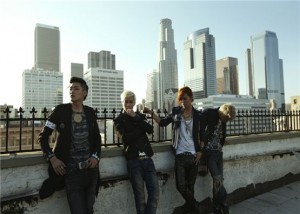 In the MV for “It’s Only Hard for Me,” the city is used to symbolically represent the feelings conveyed in the song. The attractiveness of Los Angeles’ famous scenery is contrasted with less appealing backdrops like the fire escapes of a back alley, a parking attendant booth of a parking lot, and a desert area littered with abandoned cars and a trailer. The song is about a dilemma of whether to cling to a past relationship even though one’s feelings are not being reciprocated, or to leave the relationship because the pain is too hard to bear. Such a dilemma is embodied in the sweet chorus in which Kangnam pleads for his lover to stay by his side while the rap verses express the pain that is felt by the other members and how they are not going to live with it anymore. The visual clash between the alluring, iconic scenery and the mundane, everyday backdrops of Los Angeles matches very well with the inner struggle that is expressed in the song’s lyrics and the inconsistent tone between its verses and chorus. In the end, the members of M.I.B. are shown walking off into the lonely desert while their final verse clearly expresses that they have decided to move on.
In the MV for “It’s Only Hard for Me,” the city is used to symbolically represent the feelings conveyed in the song. The attractiveness of Los Angeles’ famous scenery is contrasted with less appealing backdrops like the fire escapes of a back alley, a parking attendant booth of a parking lot, and a desert area littered with abandoned cars and a trailer. The song is about a dilemma of whether to cling to a past relationship even though one’s feelings are not being reciprocated, or to leave the relationship because the pain is too hard to bear. Such a dilemma is embodied in the sweet chorus in which Kangnam pleads for his lover to stay by his side while the rap verses express the pain that is felt by the other members and how they are not going to live with it anymore. The visual clash between the alluring, iconic scenery and the mundane, everyday backdrops of Los Angeles matches very well with the inner struggle that is expressed in the song’s lyrics and the inconsistent tone between its verses and chorus. In the end, the members of M.I.B. are shown walking off into the lonely desert while their final verse clearly expresses that they have decided to move on.
Los Angeles’ iconic backdrops also serve as Junsu’s playground in the MV for “Uncommitted” where he courts women and blends in with the scenery. Since the MV focuses specifically on a storyline involving Junsu finding another woman after his former lover accused him of being unable to commit, the city is portrayed as an urban backdrop in which Junsu has the liberty to be the “player” that his character claims to be. As for the scenery distribution, most of the action takes place in a luxurious apartment, in the nightclub, or in a generic desert environment, so shots of the city’s famous scenery are actually rather limited. Although I felt that the idea of framing Los Angeles as simply a stage for Junsu to be a womanizer was a bit forced, and that Las Vegas would have been a better backdrop for such a concept, I couldn’t help but buy into the Hollywood playboy swagger that Junsu adapted to go with the feel of the city. “Uncommitted” also ends in the desert with a defining moment between Junsu and his new love interest, but instead of allowing the desert to clear Junsu’s mind in making the right decision, it’s the place where he confirms the womanizing tendencies he was so accused of. Again, we have another example of how a foreign setting and the presence of a sexy Caucasian woman gives idols the right to behave in a way that is not necessarily considered kosher idol behavior.
Our last stop is the historic New York City, the Big Apple, the setting of Big Bang’s “Blue” and “Bad Boy,” as well as Beast’s “Beautiful Night.” I omit Beast’s “Midnight” from the discussion since it is only a short MV and it follows the exact same aesthetics that are designed for “Beautiful Night.” New York City is home to many diverse settings that are depicted very differently in these three MVs. From the cold and desolate outskirts in “Blue,” to the trendy red light district in “Bad Boy,” to the hip inner-city neighborhood in “Beautiful Night,” these different locales have been constructed to fit the mood of each of these songs, some better than others.
“Blue” actually does very little in utilizing the backdrop of New York City in its setting, but that’s because it doesn’t need to. The utter simplicity of the setting, artistically shot in black and white, sets the right mood for a song about feeling numb from longing for a lover who was unwillingly let go. Aside from shots of the Brooklyn Bridge and a single shot of the Manhattan skyline, it’s actually hard to tell that they are even in New York (maybe it’s because the MV was mostly shot in Brooklyn). Nevertheless, the outskirts industrial area of New York City with its cold rooftops, chain-linked amusement park, cramped living space, and lonely back streets creates a somber and distant setting that fits almost perfectly with the mood of the song.
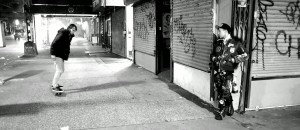 While “Blue” is noted for its simplicity and unaltered approach towards portraying a part of New York City, “Bad Boy” takes a step towards modifying the viewing experience by adding in cultural elements that influences the audience into believing they are experiencing a more authentic New York City. Transitioning from “Blue,” the video begins in black and white and gradually fades into color. This time there is much more recognizable New York City scenery like the elevated subway, taxis, metered streets, and small businesses sprawled along the commercial area. However, sprinkled into the natural urban scenery are obvious cultural implants such as the bicyclist, the skateboarder, and the vandalistic graffiti that is scrawled all over the metal security doors of closed shops. The added cultural elements meant to give off a greater sense of street credibility are nonetheless passable despite them being noticeably inserted. The result is a thuggish street vibe that plays fittingly into a song about the regrets of a male who has treated his ex-girlfriend poorly, thus making him a bad boy.
While “Blue” is noted for its simplicity and unaltered approach towards portraying a part of New York City, “Bad Boy” takes a step towards modifying the viewing experience by adding in cultural elements that influences the audience into believing they are experiencing a more authentic New York City. Transitioning from “Blue,” the video begins in black and white and gradually fades into color. This time there is much more recognizable New York City scenery like the elevated subway, taxis, metered streets, and small businesses sprawled along the commercial area. However, sprinkled into the natural urban scenery are obvious cultural implants such as the bicyclist, the skateboarder, and the vandalistic graffiti that is scrawled all over the metal security doors of closed shops. The added cultural elements meant to give off a greater sense of street credibility are nonetheless passable despite them being noticeably inserted. The result is a thuggish street vibe that plays fittingly into a song about the regrets of a male who has treated his ex-girlfriend poorly, thus making him a bad boy.
After viewing “Blue” and “Bad Boy,” New York City becomes almost unrecognizable in “Beautiful Night” as the cultural implants virtually jump off the screen. Firstly, the MV is really colorful, more colorful than any place in the real world. Secondly, the MV goes overboard in depicting New York City’s urban hip hop scene. The skateboarders and bicyclists in “Bad Boy” have been abducted and forced to do crazy stunts in front of the camera. The graffiti artists have also been coerced into painting back alley murals dedicated to Beast, with only a hint of vandalistic graffiti to maintain any sense of realism. Throw in some guys who can perform urban street dances and the illusion is complete. But wait. The people and the crowds are all obviously fake as evidenced by one controversial Craigslist ad. Furthermore, submerging Beast into this caricature of an inner-city neighborhood makes them seem even more blatantly out of place. Just because they are strutting down the streets, or posing in fixed-up hot rods and low riders, or performing a concert on top of an apartment building with fireworks going off in the background, does not make them a part of the inner-city hip hop scene. These things do not give off the impression that they are in touch with the urban street life of New York City. Lastly, for a song about honeymooning in the nighttime, where are the scenes of New York City’s actual nightlife?
Well, I hope you’ve enjoyed our three-city tour of US cities in K-pop MVs. Here is a quick recap. Las Vegas is the city of sin but it also seems to be the city of loneliness. Los Angeles is a good place for getting over someone whether it’s through painful contemplation or shameless womanizing. New York City can be a very desolate spot, but with either a handful or a boatload of added cultural elements, it may also be hip and trendy, or just plain weird. Which American city suits your tastes best?
(Images via YG Entertainment, Cube Entertainment, CJeS Entertainment)
